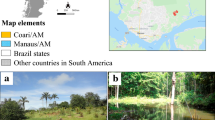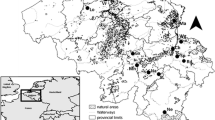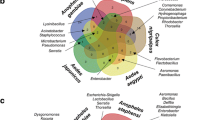Abstract
The genetic manipulation of the microbial community associated with hematophagus insects is particularly relevant for public health applications. Within mosquito populations, this relationship has been overlooked until recently. New advances in molecular biotechnology propose the genetic manipulation of mosquito symbionts to prevent the transmission of pathogens to humans by interfering with the obligatory life cycle stages within the insect through the use of effector molecules. This approach, defined as ‘paratransgenesis’, has opened the way for the investigation and characterization of microbes residing in the mosquito body, particularly those localised within the gut. Some interesting bacteria have been identified as candidates for genetic modification, however, endosymbiotic yeasts remain largely unexplored with little information on the symbiotic relationships to date. Here we review the recent report of symbiotic relationship between Wickerhamomyces anomalus (Pichia anomala) and several mosquito vector species as promising methods to implement control of mosquito-borne diseases.


Similar content being viewed by others
References
Beard CB, Dotson EM, Pennington PM, Eichler S, Cordon-Rosales C, Durvasula RV (2001) Bacterial symbiosis and paratransgenic control of vector-borne Chagas disease. Int J Parasitol 31:621–627
Beier JC (1998) Malaria parasite development in mosquitoes. Annu Rev Entomol 43:519–543
Benda N, Boucias D, Torto B, Teal P (2008) Detection and characterisation of Kodamaea ohmeri associated with small hive beetle Aethina tumida infesting honey bee hives. J Apic Res 47:193–200
Bruce-Chwatt LJ (1985) Essential Malariology, 2nd edn. William Heinemann Medical Books, London
Chen HL, Su HP, Lin CW (1998) Characterization of yeast cultures for a flavouring agent in a yoghurt-type product. J Food Sci 63:897–900
Crotti E, Damiani C, Pajoro M, Gonella E, Rizzi A, Ricci I, Negri I, Scuppa P, Rossi P, Ballarini P, Raddadi N, Marzorati M, Sacchi L, Clementi E, Genchi M, Mandrioli M, Bandi C, Favia G, Alma A, Daffonchio D (2009) Asaia, a versatile acetic acid bacterial symbiont, capable of cross-colonizing insects of phylogenetically distant genera and orders. Environ Microbiol 11:3252–3264
Damiani C, Ricci I, Crotti E, Rossi P, Rizzi A, Scuppa P, Esposito F, Bandi C, Daffonchio D, Favia G (2008) Paternal transmission of symbiotic bacteria in malaria vectors. Curr Biol 18:1087–1088
Damiani C, Ricci I, Crotti E, Rossi P, Rizzi A, Scuppa P, Capone A, Ulissi U, Epis S, Genchi M, Sagnon N, Faye I, Kang A, Chouaia B, Whitehorn C, Moussa GW, Mandrioli M, Esposito F, Sacchi L, Bandi C, Daffonchio D, Favia G (2010) Mosquito-Bacteria Symbiosis: The Case of Anopheles gambiae and Asaia. Microbiol Ecol. doi:10.1007/s00248-010-9704-8
de Bary A (1879) The Phenomenon of Symbiosis. Karl J Trubner, Strasbourgh
Dong Y, Manfredini F, Dimopoulos G (2009) Implication of the mosquito midgut microbiota in the defense against malaria parasites. PLoS Pathog 5:e1000423
Dowd PF (1989) In situ production of hydrolytic detoxifying enzymes by symbiotic yeasts of cigarette beetle (Coleoptera: Anobiidae). J Econ Entomol 82:396–400
Dowd PF (1991) Symbiont-mediated detoxification in insect herbivores. In: Barbosa P, Krischik VA, Jones CG (eds) Microbial Mediation of Plant–Herbivore Interactions. John Wiley & Sons, New York, pp 411–440
Durvasula RV, Sundaram RK, Kirsch P, Hurwitz I, Crawford CV, Dotson E, Beard CB (2008) Genetic transformation of a Corynebacterial symbiont from the Chagas disease vector Triatoma infestans. Exp Parasitol 119:94–98
Favia G, Ricci I, Damiani C, Raddadi N, Crotti E, Marzorati M et al (2007) Bacteria of the genus Asaia stably associate with Anopheles stephensi, an Asian malarial mosquito vector. Proc Natl AcadSci U S A 104:9047–9051
Favia G, Ricci I, Marzorati M, Negri I, Alma A, Sacchi L, Bandi C, Daffonchio D (2008) Bacteria of the genus Asaia: a potential paratransgenic weapon against malaria. Adv Exp Med Biol 627:49–59
Fredlund E, Druvefors U, Boysen ME, Lingsten KJ, Schnürer J (2002) Physiological characteristics of the biocontrol yeast Pichia anomala J121. FEMS Yeast Res 2:395–402
Gibson CM, Hunter MS (2005) A reconsideration of the role of yeast associated with Chrysoperla lacewings. Biol Contr 32:57–64
Gibson CM, Hunter MS (2009) Negative fitness consequences and transmission dynamics of a heritable fungal symbiont in a parasitic wasp. Appl Environ Microbiol 75:3115–3119
Glushakova AM, Maximova IA, Kachalkin AV, Yurkov AM (2010) Ogataea cecidiorum sp. nov., a methanol-assimilating yeast isolated from galls on willow leaves. Antonie Van Leeuwenhoek 98:93–101
Gusmão DS, Santos AV, Marini DC, Russo Ede S, Peixoto AM, Bacci Júnior M et al (2007) First isolation of microorganisms from the gut diverticulum of Aedes aegypti (Diptera: Culicidae): new perspectives for an insect-bacteria association. Mem Inst Oswaldo Cruz 102:919–924
Gusmão DS, Santos AV, Marini DC, Bacci M Jr, Berbert-Molina MA, Lemos FJ (2010) Culture-dependent and culture-independent characterization of microorganisms associated with Aedes aegypti (Diptera: Culicidae) (L.) and dynamics of bacterial colonization in the midgut. Acta Trop 115:275–281
Ignatova EA, Nagornaia SS, Povazhnaia TN, Ianishevskaia GS (1996) The yeast flora of blood-sucking mosquitoes. Mikrobiol Z 58:12–15
Kajla MK, Andreeva O, Gilbreath TM III, Paskewitz SM (2010) Characterization of expression, activity and role in antibacterial immunity of Anopheles gambiae lysozyme c-1. Comp Biochem Physiol B Biochem Mol Biol 155:201–209
Kalenic S, Jandrlic M, Vegar V, Zuech N, Sekulic A, Mlinaric-Missoni E (2001) Hansenula anomala outbreak at a surgical intensive care unit: a search for risk factors. Eur J Epidemiol 17:491–496
Klowden MJ, Briegel H (1994) Mosquito gonotrophic cycle and multiple feeding potential: contrasts between Anopheles and Aedes (Diptera: Culicidae). J Med Entomol 31:618–622
Kudo T (2009) Termite-microbe symbiotic system and its efficient degradation of lignocellulose. Biosci Biotechnol Biochem 73:2561–2567
Kurtzman CP (2001) Four new Candida species from geographically diverse locations. Antonie Van Leeuwenhoek 79:353–361
Magliani W, Conti S, Arseni S, Frazzi R, Salati A, Polonelli L (2001) Killer anti-idiotypes in the control of fungal infections. Curr Opin Investig Drugs 2:477–479
Meister S, Agianian B, Turlure F, Relógio A, Morlais I, Kafatos FC, Christophides GK (2009) Anopheles gambiae PGRPLC-mediated defense against bacteria modulates infections with malaria parasites. PLoS Pathog 5:e1000542
Michalcakova S, Sulo P, Slavikova E (1993) Killer yeasts of Kluyveromyces and Hansenula genera with potential application in fermentation and therapy. Acta Biotechnol 4:341–350
Moran NA, McCutcheon JP, Nakabachi A (2008) Genomics and evolution of heritable bacterial symbionts. Annu Rev Genet 42:165–190
Morrissey JP, Walsh UF, O’Donnell A, Moënne-Loccoz Y, O’Gara F (2002) Exploitation of genetically modified inoculants for industrial ecology applications. Antonie Van Leeuwenhoek. 81:599–606
Palpacelli V, Ciani V, Rossini G (1991) Activity of different killer yeasts on strains of yeast species undesirable in the food industry. FEMS Microbiol Lett 68:75–78
Pasqualotto AC, Sukiennik TC, Severo LC, de Amorim CS, Colombo AL (2005) An outbreak of Pichia anomala fungemia in a Brazilian pediatric intensive care unit. Infect Control Hosp Epidemiol 26:553–558
Passoth V, Fredlund E, Druvefors UA, Schnürer J (2006) Biotechnology, physiology and genetics of the yeast Pichia anomala. FEMS Yeast Res 6:3–13
Paupy C, Delatte H, Bagny L, Corbel V, Fontenille D (2009) Aedes albopictus, an arbovirus vector: from the darkness to the light. Microbes Infect 11:1177–1185
Phelan PL, Lin HC (1991) Chemical characterization of fruit and fungal volatiles attractive to dried-fruit beetle, Carpophilus hemipterus (L.) (Coleoptera: Nitidulidae). J Chem Ecol 17:1253–1272
Polonelli L (2000) Human, monoclonal and recombinant candidacidal, pneumocysticidal and mycobactericidal antibodies. Indian J Chest Dis Allied Sci 42:259–263
Rashed SS, Mulla MS (1989) Factors influencing ingestion of particulate materials by mosquito larvae (Diptera: Culicidae). J Med Entomol 26:210–216
Reeves WK (2004) Oviposition by Aedes aegypti (Diptera: Culicidae) in relation to conspecific larvae infected with internal symbiotes. J Vector Ecol 29:159–163
Ricci I, Damiani C, Scuppa P, Mosca M, Crotti E, Rossi P, Rizzi A, Capone A, Gonella E, Ballarini P, Chouaia B, Sagnon N, Esposito F, Alma A, Mandrioli M, Sacchi L, Bandi C, Daffonchio D, Favia G. (2010) The yeast Wickerhamomyces anomalus (Pichia anomala) inhabits the midgut and reproductive system of the Asian malaria vector Anopheles stephensi. Environ Microbiol (in press)
Riehle MA, Jacobs-Lorena M (2005) Using bacteria to express and display anti-parasite molecules in mosquitoes: current and future strategies. Insect Biochem Mol Biol 35:699–707
Riehle MA, Moreira CK, Lampe D, Lauzon C, Jacobs-Lorena M (2007) Using bacteria to express and display anti-Plasmodium molecules in the mosquito midgut. Int J Parasitol 37:595–603
Rosa CA, Lachance MA, Silva JO, Teixeira AC, Marini MM, Antonini Y, Martins RP (2003) Yeast communities associated with stingless bees. FEMS Yeast Res 4:271–275
Sacchi L, Genchi M, Clementi E, Bigliardi E, Avanzati AM, Pajoro M, Negri I, Marzorati M, Gonella E, Alma A, Daffonchio D, Bandi C (2008) Multiple symbiosis in the leafhopper Scaphoideus titanus (Hemiptera: Cicadellidae): details of transovarial transmission of Cardinium sp. and yeast-like endosymbionts. Tissue Cell 40:231–242
Saridaki A, Bourtzis K (2010) Wolbachia: more than just a bug in insects genitals. Curr Opin Microbiol 13:67–72
Savoia D, Avanzini C, Conti S, Magliani V, Frazzi R, Polonelli L (2002) In vitro leishmanicidal activity of a monoclonal antibody mimicking a yeast killer toxin. J Eukaryot Microbiol 49:319–323
Séguy N, Polonelli L, Dei-Cas E, Cailliez JC (1998) Effect of a killer toxin of Pichia anomala to Pneumocystis. Perspectives in the control of pneumocystosis. FEMS Immunol Med Microbiol 22:145–149
Shepherd R, Rockey J, Sutherland IW, Roller S (1995) Novel bioemulsifiers from microorganisms for use in foods. J Biotechnol 40:207–217
Suh SO, Marshall CJ, McHugh JV, Blackwell M (2003) Wood ingestion by passalid beetles in the presence of xylose-fermenting gut yeasts. Mol Ecol 12:3137–3145
Thuler LC, Faivichenco S, Velasco E, Martins CA, Nascimento CR, Castilho IA (1997) Fungaemia caused by Hansenula anomala-an outbreak in a cancer hospital. Mycoses 40:193–196
Torto B, Boucias DG, Arbogast RT, Tumlinson JH, Teal PE (2007) Multitrophic interaction facilitates parasite-host relationship between an invasive beetle and the honey bee. Proceedings of the National Academy of Sciences of the USA 104:8374–8378
Vega FE, Dowd PF (2005) The role of yeasts as insects endosymbionts. In: Vega FE, Blackwell M (eds) Insect-fungul associations: ecology and evolution. Oxford University Press, Oxford, United Kingdom, pp 211–243
Verhulst NO, Beijleveld H, Knols BG, Takken W, Schraa G, Bouwmeester HJ, Smallegange RC (2009) Cultured skin microbiota attracts malaria mosquitoes. Malar J 8:302
Verhulst NO, Takken W, Dicke M, Schraa G, Smallegange RC (2010) Chemical ecology of interactions between human skin microbiota and mosquitoes. FEMS Microbiol Ecol. doi:10.1111/j.1574-6941.2010.00908.x
Walker JM (2010) Pichia anomala: cell physiology and biotechnology relative to other yeasts. Antonie van Leeuwenhoek (this volume) (in press)
Wang X, Chi Z, Yue L, Li J, Li M, Wu L (2007) A marine killer yeast against the pathogenic yeast strain in crab (Portunus trituberculatus) and an optimization of the toxin production. Microbiol Res 62:77–85
Wang L, Yue L, Chi Z, Wang X (2008) Marine killer yeasts active against a yeast strain pathogenic to crab Portunus trituberculatus. Dis Aquat Organ 80:211–218
Zacchi L, Vaughan-Martini A (2002) Yeast associated with insects in agricultural areas of Perugia. Ann Microbiol 52:237–244
Acknowledgments
I.R. was funded by “Compagnia di San Paolo” in the context of the Italian Malaria Network. E.C. and P.R. received a travel Grant from the COST Action FA0701. The research activity was supported by Firb-Ideas (Grant RBID082MLZ) and Prin 2007 (Grant 2007PK2HB7-002) both from the Italian Ministry of Education, University and Research (MIUR) to G.F.
We thank Chenoa De Freece for English revision of the manuscript.
Author information
Authors and Affiliations
Corresponding author
Additional information
We refer to ‘symbiotic relationship’ as de Bary (1879) defined it and used the term ‘endosymbiont’ to mean an internal associate of the insect including the gut.
An erratum to this article is available at http://dx.doi.org/10.1007/s10482-014-0199-z.
Rights and permissions
About this article
Cite this article
Ricci, I., Mosca, M., Valzano, M. et al. Different mosquito species host Wickerhamomyces anomalus (Pichia anomala): perspectives on vector-borne diseases symbiotic control. Antonie van Leeuwenhoek 99, 43–50 (2011). https://doi.org/10.1007/s10482-010-9532-3
Received:
Accepted:
Published:
Issue Date:
DOI: https://doi.org/10.1007/s10482-010-9532-3




